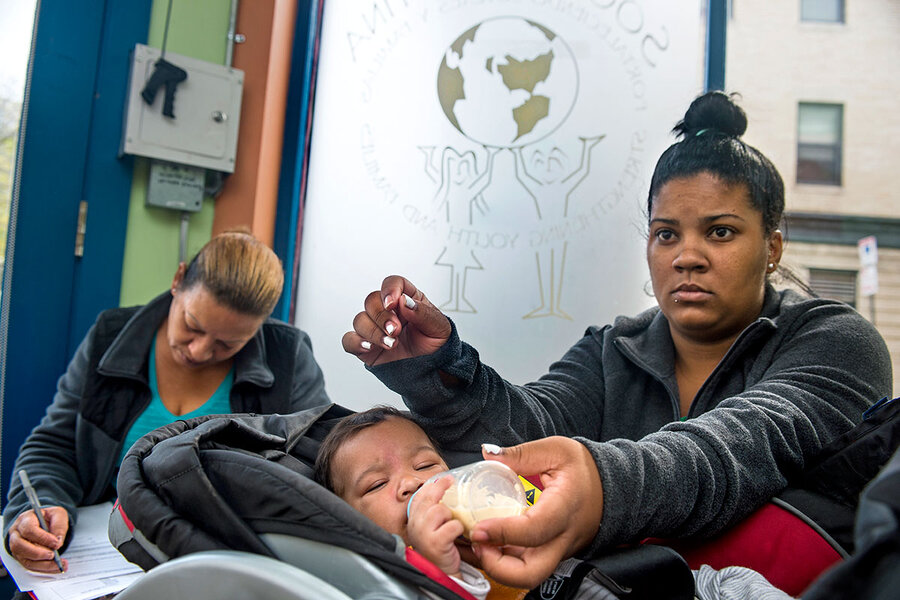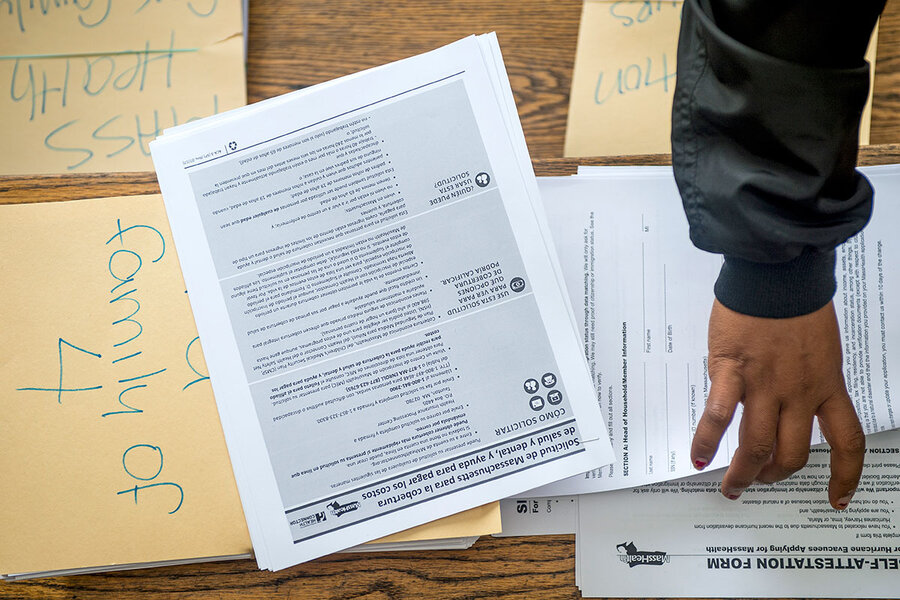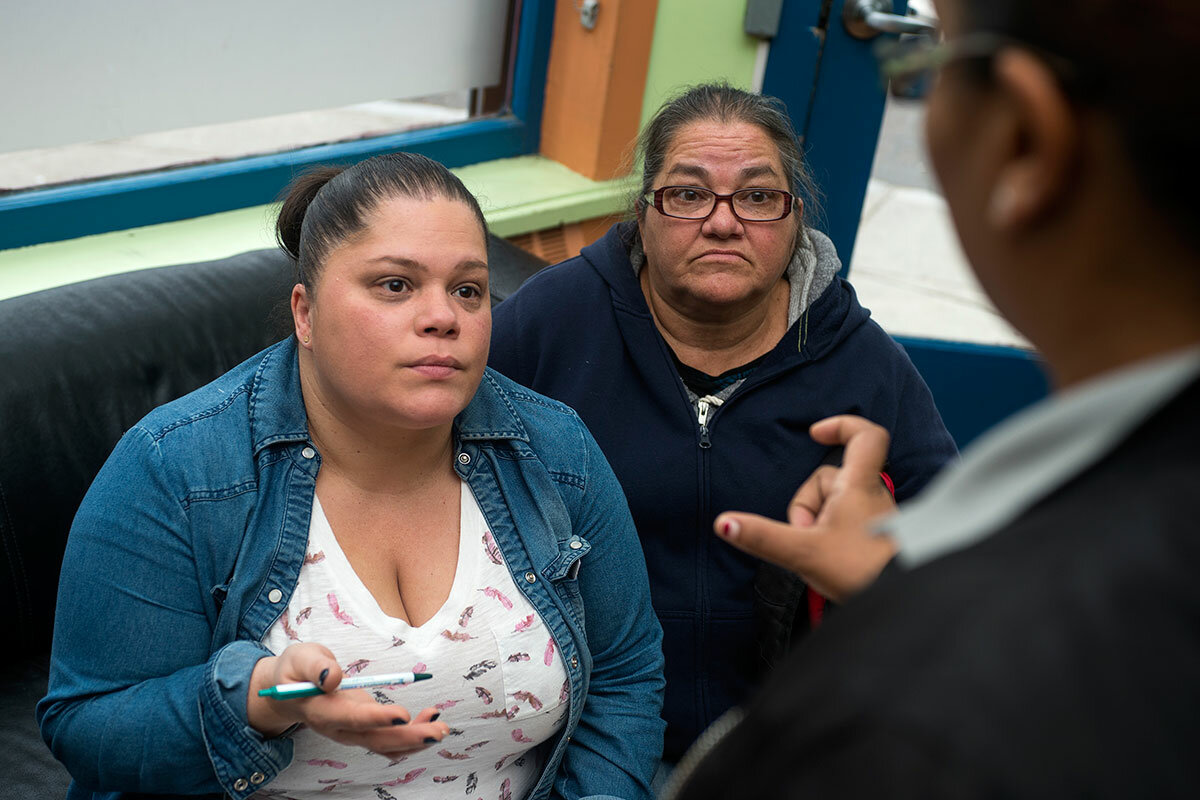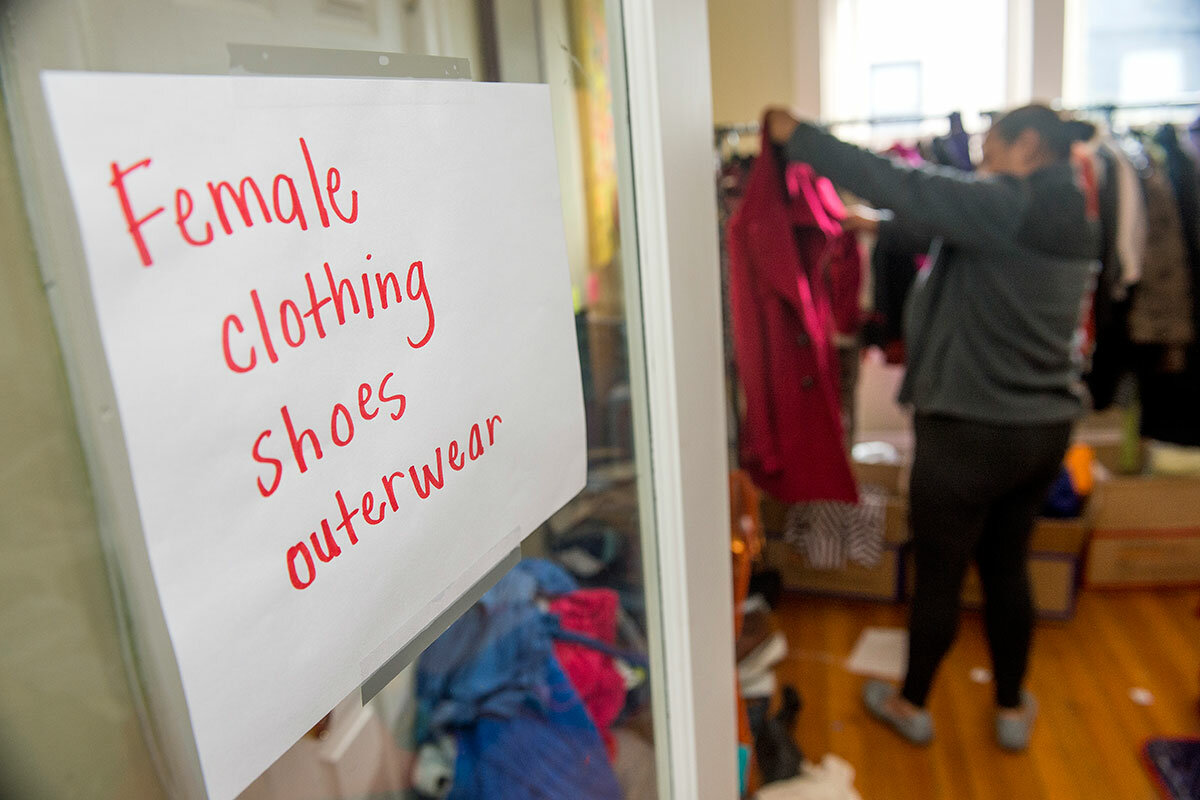After Maria: Boston uses schools as one-stop shop to assist Puerto Rican families
Loading...
| Boston
Fifteen minutes before Boston Public Schools’ pop-up welcome center at Sociedad Latina in Mission Hill is set to open for the first time, Maria Berrios is already sitting in line in a black fold-out chair. She is gripping a piece of scrap paper with a “2” written in fat Sharpie, denoting her second place in line.
Ms. Berrios fled to the Boston area with her husband, her 3-year-old daughter, and 15-year old son after hurricane Maria tore through her home in Puerto Rico. The young mother has lived in Boston before, but this is the first time her daughter has left the island.
“It’s horrible [in Puerto Rico] and that’s why I came here,” says Berrios. “We lost everything.”
She is at Sociedad Latina to sign her children up for school, she says. She doesn’t care which school – and if BPS and the city can help her find housing, they will live anywhere. Because going back is not an option.
“There is no school. There is no water. For an adult it’s OK because you know how to deal with it, but for a kid…” Berrios trails off, shaking her head. “For a kid, no.”
Boston joins other US cities – from Orlando, Fla. to Hartford, Conn. – in welcoming Puerto Rican students displaced by a hurricane that has resulted in the longest blackout in US history. Six weeks after the storm hit, 70 percent of the island was still without power, and health concerns surrounding the water system remain. Damage estimates range from $45 billion to $95 billion – an entire year's estimated economic output.
Boston's approach is one possible model for how cities can support families affected by disasters warmly and efficiently, by centralizing all of its relief assistance in one place. The city is using its public school system as its main source of outreach to Puerto Ricans, providing families with the government programs and basic resources they need to make children feel a part of the community and succeed in the classroom.
“We have a one-stop shop to make this transition as easy as possible for our families,” says BPS Superintendent Tommy Chang. “We know that we need to create stability for these young people as quickly as possible… Without housing, without some of the basic needs, our young people are not going to be able to focus on [their] transition to school.”
Research after hurricane Katrina has shown the importance of making that transition as smooth as possible: A study done five years after the storm devastated New Orleans showed that 34 percent of affected middle- and high-schoolers were a grade level behind. Students also were 4.5 times as likely to be diagnosed with symptoms consistent with emotional disturbance as their peers, according to the study by the Children’s Health Fund, Columbia University Mailman School of Public Health, and the National Center for Disaster Preparedness.
Before Maria, Boston had a Puerto Rican population of roughly 126,000, one of the largest in the country. Soon after the hurricane hit, city leaders started preparing for the arrival of hundreds – or thousands – of Puerto Ricans.
In addition to Boston Public Schools’ year-round welcome centers where parents can ask questions or enroll their children in school, “pop-up centers” at three Latino community centers – Inquilinos Boricuas en Acción in the South End, South Boston en Acción, and Sociedad Latina – opened last week.
Among the services provided to families from Puerto Rico and the Caribbean Islands are: enrolling students in school, registering for Federal Emergency Management Agency disaster relief, and applying for access to Mass Health, housing and food assistance, and to other resources, such as coats and school supplies.
As of Oct. 31, 68 children from Puerto Rico had enrolled in BPS. The city plans to keep the current pop-up centers open for a month as more direct flights reach Boston from Puerto Rico. District officials say they have no way to know the final number of students who will enroll – it could be between 200 or 2,000.
"It has been amazing to see numerous City departments and organizations step up to help families from Puerto Rico and the Caribbean islands,” says Boston Mayor Marty Walsh in an email. “I applaud the Boston Public Schools (BPS) and Superintendent Tommy Chang for embracing our new families … Bostonians always help one another in a time of need, and this instance is no different.”
'We're here for everyone'
Relief efforts for BPS are being led by Sonia Gómez-Banrey, the director of BPS’s Countdown to Kindergarten program and a native Puerto Rican. In September, Ms. Gómez-Banrey volunteered for the job and started preparing to help families she had never met, while simultaneously trying to get her own mother and five nieces and nephews to Boston. Her family arrived at the end of October, and now she spends her time floating between the pop-up centers.
“It was a packed house in here yesterday,” says Gómez-Banrey, while overseeing the efforts at Inquilinos Boricuas en Acción on Oct. 24. The previous day, the staff had helped seven children enroll in BPS.
An older woman sits in the back of the room with a BPS employee in front of a large desktop computer with a screen that reads “FEMA ASSISTANCE.” Speaking softly in Spanish, the older woman is shuffling around a deck of photos, featuring a flooded living room and a yard scattered with trees and debris.
“BPS is part of the Boston community,” says Gómez-Banrey, looking back at the older woman. “Anyone can walk through these doors and we’ll help… we’re here for everyone.”
New partnerships
Before the pop-up centers opened, BPS trained 31 volunteers from the three community centers on the basics of registering families for school and other services. Many of Sociedad Latina’s 14-person staff are Puerto Rican, says associate director Lydia Emmons. During training, several were still waiting to hear from their own families on the island.
“Knowing that we do have these resources available to us through Boston Public Schools, has been really helpful and has given us the capacity to say, ‘Yes, we will figure this out with you,’ ” says Ms. Emmons. “BPS is able to leverage a lot of support that three small community organizations might not be able to do independently.”
In return, BPS can make pop-up centers approachable: by locating them in neighborhoods with large Latino populations and in centers where there are already bilingual staff members who might have worked with the newcomers’ family or friends. As of Oct. 27, Sociedad Latina had helped 35 families and 90 individuals.
“We have the cultural competency to be working with families, and families may feel more comfortable accessing services in our building than navigating the district,” says Emmons.
Other outlets for help
Community centers haven’t been the only ones to lend a hand for Puerto Rican children. Lynn Margherio, founder and director of the Boston nonprofit Cradles to Crayons, also started brainstorming immediately after the hurricane.
“As we thought ‘How can we step in here? What can we meaningfully do?’ we started to put feelers out to anticipate what was going to happen here in Massachusetts,” says Ms. Margherio. “Our mission is to collect the very things that are being lost in the hurricanes.”
In the organization's warehouse in Brighton, Mass. – which is slightly smaller than a football field – hundreds of volunteers sort clothes, toys, and school supplies by age and gender. School districts across Massachusetts, including BPS, Holyoke, Mass., and Lawrence, Mass., reached out to Cradles to Crayons and asked for a donation of 750 backpacks, filled with school supplies, for new Puerto Rican students. Almost immediately, the company Cultural Care Au Pair in Boston called willing to help with that need – and then some – offering 2,500 filled backpacks.
Now Cradles to Crayons is fundraising with the hope of pairing each of those school packs with a “winter pack,” that has a coat, gloves, and hat, to support students not used to temperatures in January below 70 degrees F.
Margherio says the community needs to think in terms of, “ ‘Well what is it that my son or daughter would need?’ That mental checklist that every parent goes through.”
Among the remaining issues: housing
BPS had openings for about 200 students as of late October, but Superintendent Chang told reporters last week that, “if we need more seats, we will create more seats.” When it comes to housing, however, the city doesn't have as much availability.
“The one piece that none of us have been able to put our finger on, is where people are going to live,” says Emmons, from Sociedad Latina. “It’s the No. 1 question we've received and the question we have zero answers for.” She says there is already a five-year waiting list for Boston public housing, and shelters are full.
But city leaders continue to exude a calm confidence. Boston has already been creative in its initial response plan, Emmons adds, so the city just needs to think creatively about long-term housing as well.
“We’ve seen in Boston, time and again, that when there is an emergency, or when there is a real significant need, that this Boston community responds,” says Margherio. “We are ‘Boston Strong,’ after all.”
Editor's note: Due to incorrect information provided to the Monitor, this article has been updated to reflect that the organization that provided 2,500 filled backpacks to Cradles to Crayons is Cultural Care Au Pair.











